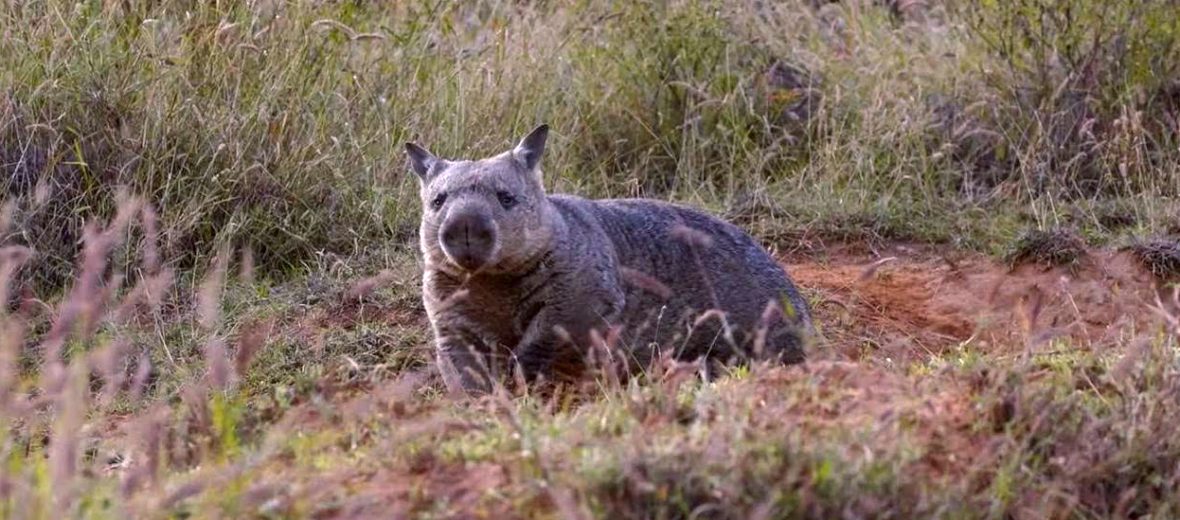
The northern hairy-nosed wombat, aka Nhn, Yaminon, Wombat À Nez Poilu De Queensland, or Wombat À Narines Poilues Du Queensland, hails only from the Epping Forest National Park, found northwest of Clermont in Central Queensland. They prefer gum tree woodlands, semi-arid sandy grasslands, eucalypt habitats, and habitats abundant with acacia. Due to habitat destruction at the hands of farming, ranching, and logging; fires and fire suppression; problems with native and invasive species (and with them disease, predation, and competition for food); and climate change (causing severe droughts), these adorable critters are listed as Critically Endangered by the IUCN. Their numbers are stable, for now, but they only number an estimated 300 wild individuals, as of 2021.
First the Stats…
Scientific name: Lasiorhinus krefftii
Weight: Up to 70.55 lbs.
Length: Up to 3.28 feet
Height: Up to 13.78 inches
Lifespan: Up to 25 years
Now on to the Facts!
1.) They are among the rarest mammals in the world.
2.) These critters are very solitary and thus difficult to study in the wild.
3.) Northern hairy-nosed wombats build detailed and elongated tunnel systems called warrens.
4.) The tunnels have numerous entrances that all connect to the primary warren.
5.) They are primarily nocturnal (active at night), but will sun bathe in the early morning.
But wait, there’s more on the northern hairy-nosed wombat!
6.) A group of wombats is called a mob or wisdom, but this is seldom seen.
7.) These herbivores (eat plant matter) consume large quantities of grasses, herbs, and roots.
Did you know…?
They may be short and stout, but these critters can run up to 24.85 mph for up to 1.5 minutes!
8.) Females undergo up to a 21 day gestation (pregnancy) that yields a single joey. This joey then travels to the female’s marsupium (pouch) to continue developing for an additional 6 – 9 months.
9.) Weaning takes place in approximately 1 year.
10.) The name wombat hails from the Darug people (Sydney aborigines).
But wait, there’s more on the northern hairy-nosed wombat!
11.) Like other wombats, their marsupium (pouch) faces backwards. This is an evolutionary feature that keeps dirt from filling the pouch, while excavating warrens.
12.) The northern hairy-nosed wombat is the largest member of the wombat family.
Did you know…?
Just like rodents, the incisors of a wombat constantly grow and thus have to be worn down by gnawing on tough substances to keep these teeth from overgrowing.
13.) Being powerful diggers. They can excavate up to 3 feet of earth per day.
14.) It can take upwards of 2 weeks to digest a day’s meal. This is another evolutionary adaptation from living in a desert environment with little food.
15.) They possess a plate of cartilage in their rear that acts as a shield against predators. When pursued by a predator, they will flee to their warren, head first, and block the entrance with their rump. If a predator tries to pull the wombat out, they simply raise their rear end upwards and trap the predator between their rump and the roof of the warren… smashing the predator.
16.) And another interesting fact that occurs in all wombats, is that they have a special bone in their rectum that shapes their feces (poop) into little squares. These square poop pellets are stacked at the entrance of their warren as a signal to stay away.
Now a Short Northern Hairy-Nosed Wombat Video!
Be sure to share & comment below! Also, check out the Critter Science YouTube channel. Videos added regularly!
Want to suggest a critter for me to write about? Let me know here.
Some source material acquired from: Wikipedia and IUCN
Photo credit: Donovan Klein



